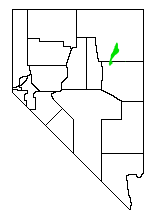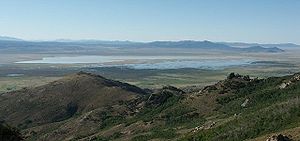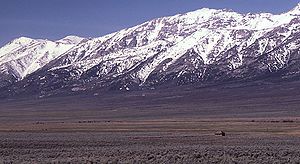
Ruby Valley
Encyclopedia

Elko County, Nevada
-Demographics:As of the census of 2000, there were 45,291 people, 15,638 households, and 11,493 families residing in the county. The population density was 3/sq mi . There were 18,456 housing units at an average density of 1/sq mi...
and northern White Pine
White Pine County, Nevada
White Pine County is a county located in the U.S. state of Nevada. Its population at the 2010 census was 10,030. Its county seat is Ely. It is the home of Great Basin National Park...
Counties in the northeastern section of the state of Nevada
Nevada
Nevada is a state in the western, mountain west, and southwestern regions of the United States. With an area of and a population of about 2.7 million, it is the 7th-largest and 35th-most populous state. Over two-thirds of Nevada's people live in the Las Vegas metropolitan area, which contains its...
in the western United States
United States
The United States of America is a federal constitutional republic comprising fifty states and a federal district...
. From Secret Pass it runs south-southwest for approximately 60 miles (96 km) to Overland Pass. To the west is the steep escarpment of the Ruby Mountains
Ruby Mountains
The Ruby Mountains comprise one of the many mountain ranges of the Great Basin in the western United States. They are the predominant range in Elko County, in the northeastern section of the state of Nevada. To the north is Secret Pass and the East Humboldt Range, and from there the Rubies run...
, and to the north is the East Humboldt Range
East Humboldt Range
The East Humboldt Range is a line of mountains in northeastern Nevada in the Great Basin region of the western United States. It located in central Elko County in the upper watershed of the Humboldt River, which flows to the southwest from its source just north of the range.The East Humboldts run...
and Clover Valley. The east side of the valley is less well defined, but its maximum width is about 10 miles (16 km) near Franklin Lake. At its south end lies the Ruby Lake National Wildlife Refuge
Ruby Lake National Wildlife Refuge
The Ruby Lake National Wildlife Refuge is located in southwestern Elko County and northwestern White Pine County in the northeastern section of the state of Nevada in the western United States. Established in 1938, it encompasses 37,632 acres of wetlands in Ruby Valley, just east of the Ruby...
. U.S. Route 93
U.S. Route 93 in Nevada
In the U.S. state of Nevada, U.S. Route 93 is a major U.S. highway traversing the eastern edge of the state. The highway connects the Las Vegas area to the Great Basin National Park, and provides further connections to Ely and Wells...
passes along the northeast edge of the valley, and the Ruby Valley Road runs along its entire western edge. Harrison Pass Road crosses the Ruby Mountains near the center of the valley. Much of the floor of Ruby Valley lies at elevations near 6000 feet (1820 m).



Great Basin
The Great Basin is the largest area of contiguous endorheic watersheds in North America and is noted for its arid conditions and Basin and Range topography that varies from the North American low point at Badwater Basin to the highest point of the contiguous United States, less than away at the...
. Nomadic tribes of the Shoshone
Shoshone
The Shoshone or Shoshoni are a Native American tribe in the United States with three large divisions: the Northern, the Western and the Eastern....
nation used Ruby Valley as a winter home, finding it warmer than nearby locations. The California Trail
California Trail
The California Trail was an emigrant trail of about across the western half of the North American continent from Missouri River towns to what is now the state of California...
, active after the 1840s, was located just to the north. The Donner Party
Donner Party
The Donner Party was a group of American pioneers who set out for California in a wagon train. Delayed by a series of mishaps, they spent the winter of 1846–47 snowbound in the Sierra Nevada...
passed through the southern end of the valley in 1846, heading for the Overland Pass route across the Ruby Mountains – part of the Hastings Cutoff
Hastings Cutoff
The Hastings Cutoff was an alternate route for emigrants to travel to California, as proposed by Lansford Hastings.In 1845, Hastings published a guide entitled The Emigrant's Guide to Oregon and California...
.
Overland Pass was also the site of much activity in the 1860s. A transportation route
Central Overland Route
The Central Overland Route was a transportation route from Salt Lake City, Utah south of the Great Salt Lake through the mountains of central Nevada and the Basin and Range Province to Carson City, Nevada...
through central Nevada had been scouted by Howard Egan in 1855, and then surveyed by Captain James H. Simpson
James H. Simpson
James Hervey Simpson was an officer in the U.S. Army and a member of the United States Topographical Engineers.-Early years:He was born in New Brunswick, New Jersey on March 9, 1813, the son of John Simpson and Mary Brunson. He graduated from the United States Military Academy in 1832 and was...
for the U.S. Army in 1859. Simpson then established a trading post at the south end of Ruby Valley, and George Chorpenning
George Chorpenning
George W. Chorpenning Jr. was a pioneer in the transportation of mail, freight, and passengers through the arid and undeveloped western regions of the United States...
built a way station there for his mail and stagecoach
Stagecoach
A stagecoach is a type of covered wagon for passengers and goods, strongly sprung and drawn by four horses, usually four-in-hand. Widely used before the introduction of railway transport, it made regular trips between stages or stations, which were places of rest provided for stagecoach travelers...
line in 1860. The Pony Express
Pony Express
The Pony Express was a fast mail service crossing the Great Plains, the Rocky Mountains, and the High Sierra from St. Joseph, Missouri, to Sacramento, California, from April 3, 1860 to October 1861...
and its successor, the Transcontinental Telegraph
First Transcontinental Telegraph
The First Transcontinental Telegraph was a milestone in electrical engineering and in the formation of the United States of America. It served as the only method of near-instantaneous communication between the east and west coasts during the 1860s....
, also ran through Overland Pass. In September 1862 the U.S. Government established Fort Ruby
Fort Ruby
Fort Ruby, also known as Camp Ruby, was built in 1862, during the American Civil War, in the "wilderness of eastern Nevada." It protected the overland mail coaches and Pony Express, which linked California to the Union...
at the east entrance to the pass, and in 1863 signed the controversial Treaty of Ruby Valley with the Shoshone. After the American Civil War
American Civil War
The American Civil War was a civil war fought in the United States of America. In response to the election of Abraham Lincoln as President of the United States, 11 southern slave states declared their secession from the United States and formed the Confederate States of America ; the other 25...
, transport service was continued by John Warren Butterfield
John Warren Butterfield
John Warren Butterfield was an operator of stagecoach and freight lines in the mid-19th century in the American Northeast and Southwest. He founded companies that became American Express and Wells Fargo. Butterfield also founded the Butterfield Overland Express and from 1858 to 1861 operated a...
and then by Wells Fargo & Co
Wells Fargo
Wells Fargo & Company is an American multinational diversified financial services company with operations around the world. Wells Fargo is the fourth largest bank in the U.S. by assets and the largest bank by market capitalization. Wells Fargo is the second largest bank in deposits, home...
. Around 1866, Wells Fargo began the first agriculture in Ruby Valley to help support its way stations.
However, in the late 1860s the Transcontinental Railroad
First Transcontinental Railroad
The First Transcontinental Railroad was a railroad line built in the United States of America between 1863 and 1869 by the Central Pacific Railroad of California and the Union Pacific Railroad that connected its statutory Eastern terminus at Council Bluffs, Iowa/Omaha, Nebraska The First...
was routed well to the north, and Overland Pass fell into disuse. Fort Ruby was closed in September 1869, just seven years after it was built. The old Pony Express Station was moved and restored, and is now part of a display at the Northeastern Nevada Museum in Elko
Elko, Nevada
Elko is a city in Elko County, Nevada, United States. The population was 18,297 at the 2010 census. It is the county seat of Elko County. The city straddles the Humboldt River....
. The valley is now sparsely settled, and principally used to raise cattle
Ranch
A ranch is an area of landscape, including various structures, given primarily to the practice of ranching, the practice of raising grazing livestock such as cattle or sheep for meat or wool. The word most often applies to livestock-raising operations in the western United States and Canada, though...
and to grow alfalfa.

